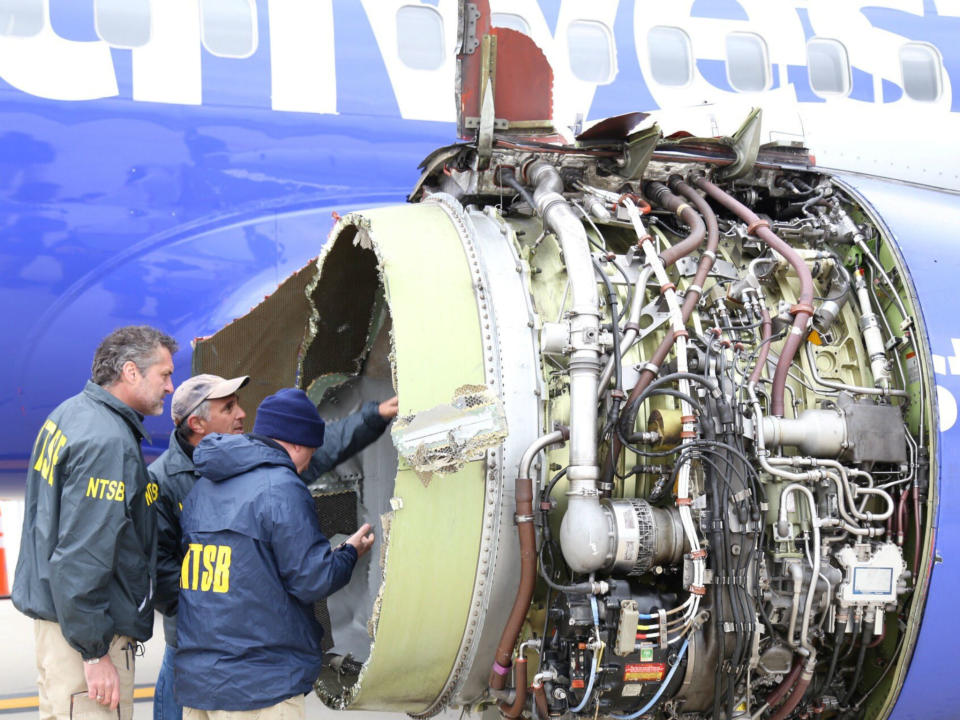Hundreds of planes in US and EU to undergo emergency inspections after fatal explosion on Southwest flight
Emergency inspections will be carried out on hundreds of aircraft worldwide after an explosion aboard a Southwest Airlines flight led to the death of a passenger.
The announcement by the Federal Aviation Administration comes after a woman was almost sucked out of a window on a flight from New York to Dallas on Tuesday, after “an engine failure due to a fractured fan blade".
Metal fatigue was believed to have led to a piece of a fan blade coming loose, according to investigators, which then smashed through the engine casing. Debris shattered a passenger window, which in turn led to decompression.
The authority fears the same problem could happen to other aircraft with the same engine model, and have ordered for almost 700 planes to be inspected, about half of which are in the US.
In an Emergency Airworthiness Directive, the FAA said: “Fan blade failure due to cracking, if not addressed, could result in an engine in-flight shutdown (IFSD), uncontained release of debris, damage to the engine, damage to the airplane, and possible airplane decompression.”
It added that “the unsafe condition is likely to exist or develop in other products of the same type design”.
The Southwest flight in question was on a Boeing Model 737-700 airplane powered by CFM56-7B model engines.
The FAA has now ordered for all engines of this type with more than 30,000 total cycles to be inspected within 20 days.
Evaluating what went wrong aboard the ill-fated Southwest flight, the investigators said the failure led to “the engine inlet cowl disintegrating” and debris penetrating the fuselage “causing a loss of pressurization and prompting an emergency descent.”
Southwest Airlines Flight 1380 had 149 people aboard when it made an emergency landing in Philadelphia.
Oxygen masks descended as the passengers endured a terrifying rapid descent.
Banking executive Jennifer Riordan, 43, of Albuquerque, New Mexico, was almost sucked out of her window when it shattered in mid-air. She was pulled back inside by fellow passengers but died from her injuries.
It was the first time in eight years that someone died in a fatal accident aboard a US airliner.
Robert Sumwalt, chairman of the National Transportation Safety Board (NTSB), said the dangerous kind of engine breakup that occurred Tuesday — called an uncontained failure because pieces were shot out like shrapnel — should not have happened.
But he and other aviation experts have cautioned against drawing any broad conclusions yet about the safety of CFM56 engines or Boeing 737 jets.
CFM International says the engines are used on 6,700 planes around the world.
Uncontained engine failures are rare — there are about three or four a year, according to Mr Sumwalt.
It is not the first time an emergency of this kind has occurred.
A similar incident aboard another Southwest flight in 2016 also involved an engine fan becoming detached and was also associated with metal fatigue.
That plane also made an emergency landing but no one was injured.
Southwest issued letters of apology to passengers who were aboard Flight 1380. US media report that each was given a $5,000 cheque and a $1,000 travel voucher.
Southwest said in a statement earlier this week that it is “accelerating its existing engine inspection program relating to the CFM56 engine family.”
“The accelerated inspections are being performed out of an abundance of caution and are expected to be completed over the next 30 days.
“The accelerated checks are ultrasonic inspections of fan blades of the CFM56 engines.
In a further statement, they acknowledged the directive issued by the FAA, adding that their “existing maintenance program meets or exceeds all the requirements specified in the Airworthiness Directive.”
Additional reporting by agencies

 Yahoo News
Yahoo News 

